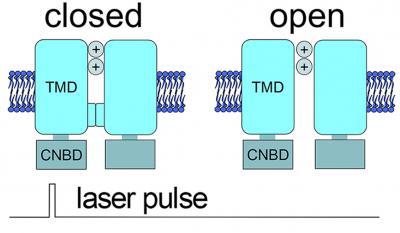Singlet oxygen is an electronically excited state of oxygen that is less stable than normal oxygen. Its high reactivity has enabled its use in photodynamic therapy, in which light is used in combination with a photosensitizing drug to generate large amounts of singlet oxygen to kill cancer cells or various pathogens.
Light-generated singlet oxygen also plays a role in a range of biological processes. It is produced during photosynthesis in plants, for example, and its production in skin cells has been linked to aging and cancer development.
Moreover, small amounts of singlet oxygen produced during metabolic reactions can act as a local signaling factor that oxidizes and modifies target molecules, but the underlying mechanisms are poorly understood. A new study in The Journal of General Physiology discusses singlet oxygen and sets the stage for better understanding of this highly reactive and challenging substance.

These schematic drawings show how researchers applied laser pulses to HCN channels tagged with a fluorescent photosensitizer to observe the effects on these channels of singlet oxygen, a highly reactive form of oxygen that plays a role in a range of biological processes including photosynthesis and skin cancer/aging. Credit: Gao et al., 2014
Lei Zhou and colleagues from Virginia Commonwealth University unveil a new technique to show how singlet oxygen modifies HCN channels— "pacemaker channels" that contribute to memory, heart rate, pain sensation, and other functions.
By applying millisecond laser light pulses to HCN channels tagged with a fluorescent photosensitizer, Zhou and colleagues were able to elicit the production of small amounts of singlet oxygen in a precise location and monitor its effects on the channels in open and closed states.
Their results indicate that some of its effects on HCN channels are state specific and involve specific modifications near the activation gate.
The findings not only help explain how singlet oxygen functions, they introduce a method that can be used for further exploration of this important signaling factor.


